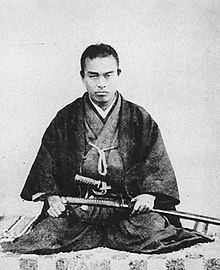Nakaoka Shintaro
Nakaoka Shintaro ( Japanese 中岡慎太郎 ; born 6. May 1838 in Kōchi ( province Tosa ); died 12. December 1867 in Kyoto ) was a Japanese opponents of the Tokugawa - shogunate in the 19th century.
Live and act
Nakaoka Shintarō was the eldest son of a high village official of the Tosa domain, felt early connected to the " Sonnō jōi " movement, which campaigned against the Tokugawa shogunate and for the restoration of imperial power. In 1862 he went to Kyoto and joined the pro-imperial activists. After the failed coup on September 30, 1863, in which the loyal to the emperor were expelled from Kyoto, the Tosa officials opted for a rather moderate line towards the shogunate. Nakaoka had to leave the domain, then joined the activists of the Chōshū domain.
In 1864 Nakaoka took part in an attempt to restore the influence of the Chōshū domain at court, but this " uprising at the Hamaguri Gate " failed and Nakaoka was wounded. In 1866 he, Sakamoto Ryōma and other Tosa representatives negotiated an alliance that included Tosa and Chōshū and the Satsuma domain. He also organized a 50-man team to carry out actions against the shogunate.
In December 1867, he and Sakamoto were attacked and killed by members of the Mimawari-gumi (見 回 り 組) of the Shogunate in Kyoto at a meeting in a tea house .
A large bronze statue of him at the lighthouse at Cape Muroto (室 戸 岬) in his home prefecture of Kōchi and another (together with Sakamoto Ryōma) in Maruyama Park in Kyoto commemorates Nakaoka .
literature
- S. Noma (Ed.): Nakaoka Shintarō . In: Japan. An Illustrated Encyclopedia. Kodansha, 1993, ISBN 4-06-205938-X , p. 1041.
| personal data | |
|---|---|
| SURNAME | Nakaoka, Shintaro |
| ALTERNATIVE NAMES | 中 岡 慎 太郎 |
| BRIEF DESCRIPTION | japanese samurai |
| DATE OF BIRTH | May 6, 1838 |
| PLACE OF BIRTH | Kochi |
| DATE OF DEATH | December 12, 1867 |
| Place of death | Kyoto |
